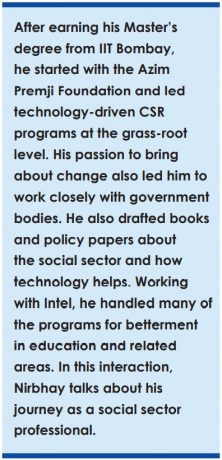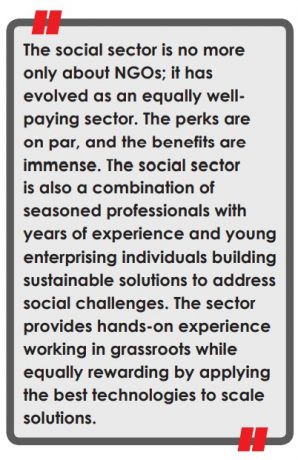
Delhi3:58 PM | 27th April 2024
The Sustainable Development Goals (SDGs) comprise 17 key targets that outline a set of goals for global development and were adopted by the UN in 2015 to update the Millennium Development Goals.



Corporate social responsibility (CSR) is one of CGI›s long-held core values and priority areas. Correspondingly, one of our strategic goals is to be recognized by our communities as caring and responsible corporate citizens. These two aims come together in our commitment to contributing to the development of an inclusive, collaborative, and sustainable world. Through our socially and environmentally sustainable business practices, we strive to deliver value for all three of our stakeholders – our clients; our employees, whom we call members as a majority of them are also owners; and our shareholders. Our ideology is not to drive CSR programs blindly but to align them with global goals, while also taking care of local concerns.

Our CSR priorities are People, Communities, and Climate. Under People, we work largely with students in schools and universities. We champion digital inclusion for all, taking actions locally to improve access to technology and business education and mentoring to ensure everyone can be successful in a digital society as citizens or IT professionals.
The second priority is Communities. We commit to positively contributing to society by leveraging our IT and business expertise through social impact projects, local economic growth initiatives, and active support for local Business Unit pro bono engagements. CGI encourages the use of our skills to support the communities in which we live and work.
The Climate priority demonstrates our commitment to an environmentally sustainable world through projects delivered in collaboration with clients, our operating practices, supply chain management, and community service activities. The goal is to achieve net-zero carbon emissions by 2030, build processes in support of change and support our clients with their climate goals.


Government is a default partner, for anything we do. No one matches their reach and opportunity to scale operations.
The social sector indeed needs massive investment for large-scale change. A collaborative effort ensures constant support with required capital. It is essential to create powerful synergies to support a favourable ecosystem for change. There is merit in co-creating programs that encourage investment in pilots and scale-up operations. With a finite timeline and exit plan, such opportunities push towards sustainable solutions.
The progressive nature of the mandate makes it flexible for companies to collaborate to engage in CSR initiatives. It certainly adds value as isolated efforts will not address complex issues such as illiteracy, poverty, unemployment, or environmental sustainability.
We have been working in collaboration with government bodies like the Niti Aayog for implementing the STEM programs. We work with over 100 schools across 3 states and reach more than 50000 children. Another program targets the National Digital literacy mission, where we work with some private sector partners as well. So, while the programs are targeted at local growth, they also serve the purpose of nation-building.
On the climate conservation side, our program for wet waste management is in collaboration with the local municipal bodies, who provide us with the assets. We recognise that they need support and we provide Capex and other operational support through our NGO partners.
A more conducive atmosphere and long-term strategy would open doors for collaborations. The government has been playing the role of regulator. It is time to step up to play as a facilitator in nation-building with a shared vision. A shared vision also brings on the table much-required compatibility among partners. The compatibility will help in bringing together competencies to address the social issues.
An example here would be company collaborations for CSR. While we do have opportunities like Swachh Ganga, Swachh Bharat, or PM relief fund, Govt. needs to come up with such platforms where companies can come ahead and provide collective effort. During the COVID times, for instance, if there was a common platform for collective action, it would have enabled more meaningful support.
Sustainable Development Goal 17, partnerships for the goals, should be essential to forging local alliances and collaborations. It will bring in required finance by mobilizing extra financial resources through private players. It will enhance the utilization of enabling innovation and technology for effective capacity-building initiatives. It would also promote public-private, civil society, and public partnerships. India is a vast and diverse country; thus, coming together is pivotal to address long-standing social issues to build a just, social and equitable society.


The Sustainable Development Goals (SDGs) comprise 17 key targets that outline a set of goals for global development and were adopted by the UN in 2015 to update the Millennium Development Goals.

Aligning CSR to SDGs allows a company to address a significant challenge of operations in multi nations as a Multi-national Corporation. It helps to devise an effective CSR approach operating across multiple jurisdictions. Given that SDGs are universal, developing a cohesive CSR approach based on SDGs is more acceptable across the borders. If I speak of APAC goals, people may not relate to them, but if I connect them to the SDGs, they will understand, as these are more shared goals.
Committing to the SDGs also increases transparency and accountability towards consumers. It is also an effective way to foster a sense of community as businesses can work closely with governments and other civil society organizations to achieve common targets. Our CSR global report is called Sustainability Reporting. It simplifies the goals that we follow.
Consumers are likely to be more loyal and stay invested in a firm’s CSR activities committed to achieving the shared goals. It is also convenient for stakeholders and shareholders as these are universal goals for building a better tomorrow. Today, it is not only about investing money. Stakeholders are looking at what is your commitment from a larger point of view. On the climate change front, we are signatories to the UN 2030 Agenda for Sustainable development.
It might be unrealistic to align all SDGs. However, a short-term strategy is to work around specific targets aligning with the existing CSR activities. It is a transition, paving the way for a longer-term approach to commit holistically to all 17 SDGs. It certainly helps businesses to reorient the purpose of the business. It is a misnomer to believe that the purpose of business is to only make a profit or to solely serve the shareholders. The ultimate aim of business is to serve society without trespassing into the community and damaging the environment.
Corporate social responsibility generates a positive atmosphere inside the organization that eventually leads to the overall improvement of the brand image. An alignment to SDGs would be able to help India to improve developmental activities and contribute directly to the national as well as global development agenda. It is certain that achieving SDGs using CSR activities as a means of shared growth.
The SDGs are like a broader umbrella, within which the CSR fits as a significant part, and the programs we have for stakeholders, customers, employees, and the community are smaller segments of the larger goal.


It is a fact that investing in education is one of the most critical components for enabling the growth and development of any country. However, it is equally important to understand where these investments are made, what inputs are provided, and how quality time is spent in schooling to contribute to economic growth.
As I mentioned, we work in collaboration with the Niti Aayog and our STEM programs impact over 50000 children from more than 100 schools annually. Today we have children cracking the state level and national level competitive exams, on all forums. We provide a platform for children to showcase their work. It encourages people to adopt a scientific mindset and rational thinking for being innovators, instead of doing rote learning.
It also helps our members, or employees, for being mentors in such a large-scale program. They help schoolchildren and influence their growth. We also offer scholarship programs at the college level. We are proud to share that we have partnerships with IIT Chennai, IIIT Hyderabad, and other universities where we provide scholarships for students who are meritorious but cannot afford the education. We handhold their journey and also get on board some of them as interns so that they are meaningfully engaged. We work with the learning and development team, which is part of the HR team.
We also do digital literacy programs to see how technology can be leveraged. We have Vodafone Idea as our partner, and there’s a portal called digisakshar.org, where they provide the platform and the program is supported by CGI. NASSCOM helped us come together for this collaboration. Apart from mainstream education, we focus on inclusive education where children with special needs, or visually impaired students are taken care of in a meaningful way. They are skillfully trained so that they are independent and they get employment.


Our operations are in Telangana, Maharashtra, Tamil Nadu. The programs are run in vernacular languages, mainly because the schools we partner with have the regional language as the medium of study, not English or the national language. We try to address their requirements as well as we can. Our science programs are in English. So, we do a mix and match of both. The program that we did with Vodafone, B-Sakshar portal, is available in Hindi, English, and vernacular languages as well. We are using these ways to scale up the opportunities.


We mostly work with in-house teams for a reason. We aim to mobilize them to meaningfully contribute to the community. One of our employees was a part of the Indo-Russian Bilateral Science program, where he mentored Indian and Russian students in building a technology solution for India. We concluded a Daan Utsav, and all employees supported it. Most of our members also promote sustainable homes, and we work with the next generation for championing the cause of ecological awareness.
Dream Connectors is an employee-driven initiative that supports communities in which we live and work. It is a global CGI initiative that advances our ongoing commitment to improving the well-being of our communities through technology and the engagement of our consultants. Dream Connectors brings together CGI consultants from across the globe to benefit local communities through global collaboration and teamwork. Every year, CGI consultants propose Dream Connectors project ideas, and a committee selects the best projects for a company-wide vote. Winning projects receive CGI support in the form of technology, funding, and volunteers.
Since the engagement programs are not possible only with the employees or CSR teams, we have our NGO partners, called Implementation Agencies. They provide the platform where we can help with expertise and technology. We do collaborate with corporates, but not so much for the volunteering. When I look at the numbers, we have close to 6500 members contributing for social causes and putting in 13000 to 14000 hours for such services.


The social sector is no more only about NGOs; it has evolved as an equally well-paying sector. The perks are on par, and the benefits are immense. The social sector is also a combination of seasoned professionals with years of experience and young enterprising individuals building sustainable solutions to address social challenges. The sector provides hands-on experience working in grassroots while equally rewarding by applying the best technologies to scale solutions. You can work and see the impact in the real sense. It is a life-changing opportunity, and students must have a passion for it.
Given the size of the social landscape, there are enormous opportunities to serve society in a personal capacity or as a full-time professional with an NGO or as Corporate Social Responsibility with a corporate. CSR is a part of the compliance requirements in India. So, all major companies have some CSR projects. More than 20000 companies have roles for CSR professionals. You can work in sustainability teams, corporate foundations, high-net-worth individuals, and many more.
From the skill point of view, a management degree is sufficient to enter the field. But having some experience of social work during college as a volunteer will always add value. You will be able to learn the skills on the way. It is all about the right combination of passion, commitment, and managerial skills.
Some universities are offering courses on social work as credit courses. We also have MBA in CSR or MBA in sustainability as new age courses. That’s an additional benefit for people who want to be a part of this space. It is all about transforming lives and working towards building a more humane and equitable society. It is empathy in action. The biggest reward, apart from building a better future for others, is job satisfaction. It is a super combination of work-life balance. The jobs in social sectors are equally rewarding with opportunities to tackle complex issues, work closely with the government, and travel for learning on the go.
Copyright© educationpost.in 2024 All Rights Reserved.
